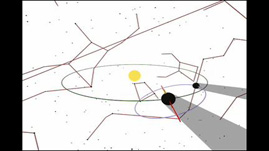Teachers' Domain - Digital Media for the Classroom and Professional Development
User: Preview



Animations and essays were created and written by Dr. Michael Gallis, the Pennsylvania State University.
Teachers who reviewed the collection were Patrick Callahan, Tara Clopper, and David R. McCachren. Instructional designer was Rucha Modak. Multimedia producer was Betsy Hutton. Director of Educational Services, Penn State Public Broadcasting is Dr. Babs Bengtson.

This animation shows several angles of the rotation of Earth, the orbit of the Moon about the Earth, and the orbit of the Earth-Moon about the Sun. The appearance of both the Sun and the Moon can be affected by the shadows cast by the Earth and the Moon in the sunlight. Because the Moon’s orbit has a slight tilt (with respect to Earth’s orbit around the Sun), usually the New Moon misses the Sun in the sky and usually the Full Moon misses the Earth’s shadow. When it doesn’t, we see a Solar or a Lunar eclipse.
The Sun appears in the sky to us, shining with its own light. The Moon, on the other hand, “shines” due to reflected sunlight. The appearance of both the Sun and the Moon can be affected by the shadows cast by the Earth and the Moon in the sunlight.
The apparent motion of the Sun and Moon across the sky (as viewed from Earth) is due to a combination of the rotation of the Earth, the orbit of the Moon about the Earth, and the orbit of the Earth-Moon system about the Sun. One unusual aspect of the Moon’s orbit is that its rotation rate is synchronized with its orbit (the time for one rotation on its axis is the same as the time for one orbit), so that it always presents the same side to the Earth, regardless of where the Moon is along its orbit.
The Moon is only illuminated on the side closest to the Sun. When the Moon is observed from Earth different amounts of that side are illuminated depending on where the Moon is on its orbit around the Earth and where the Sun is with respect to your viewing location. About once a month we see a completely illuminated (Full) Moon which occurs when the Sun and Moon are on opposite sides of the Earth. Approximately two weeks later the Sun and the Moon are on the same side of the earth, and the only part of the Moon facing the Earth is on the “night” side of the Moon (New Moon). This lunar cycle continuously repeats through all the phases of the Moon, and historically has been an important part of calendars. Thus the phases of the Moon as viewed from Earth are caused by the Moon’s position along its orbit.
At first glance, it might seem that every month during a New Moon the Moon should line up perfectly with the Sun and block the Sun from Earth’s view causing a Solar Eclipse. Similarly during a Full Moon the Moon should fall directly within Earth’s shadow causing a Lunar Eclipse. However, the Moon’s orbit has a slight tilt (with respect to Earth’s orbit about the Sun), so that usually the New Moon misses the Sun in the sky and usually the Full Moon misses Earth’s shadow. Astronomers refer to the line where the plane of the Moon’s orbit intersects the plane of Earth’s orbit as the Line of Nodes, and this can be thought of as the axis of the tilt of the Moon’s orbit. In order to have an eclipse the timing of orbits has to be just right: the Moon has to be crossing the Line of Nodes at the same time that the Line of Nodes is lined up with the Sun for an eclipse to occur.
To learn more about how eclipses occur, check out Total Solar Eclipse Animation.
To see a video of a spectacular solar eclipse, check out Eclipse of the Century.
To learn more about Solar Eclipses, check out Solar Eclipses.
To learn more about the Moon’s phases, check out The Lunar Cycle.
 Loading Standards
Loading Standards Teachers' Domain is proud to be a Pathways portal to the National Science Digital Library.
Teachers' Domain is proud to be a Pathways portal to the National Science Digital Library.
